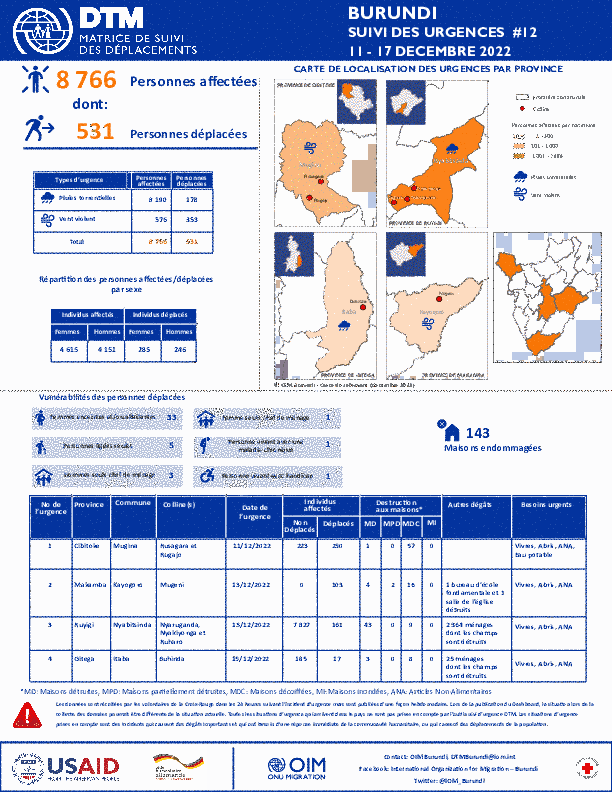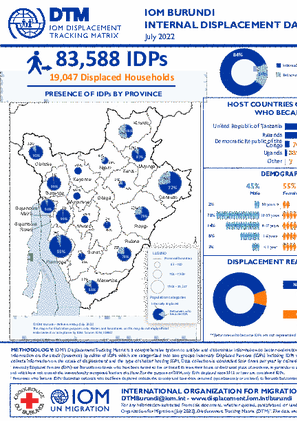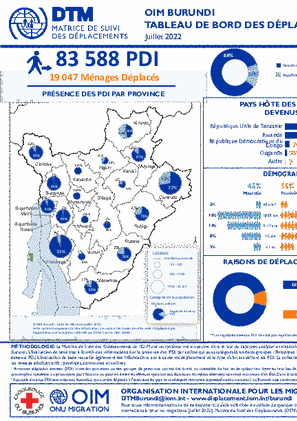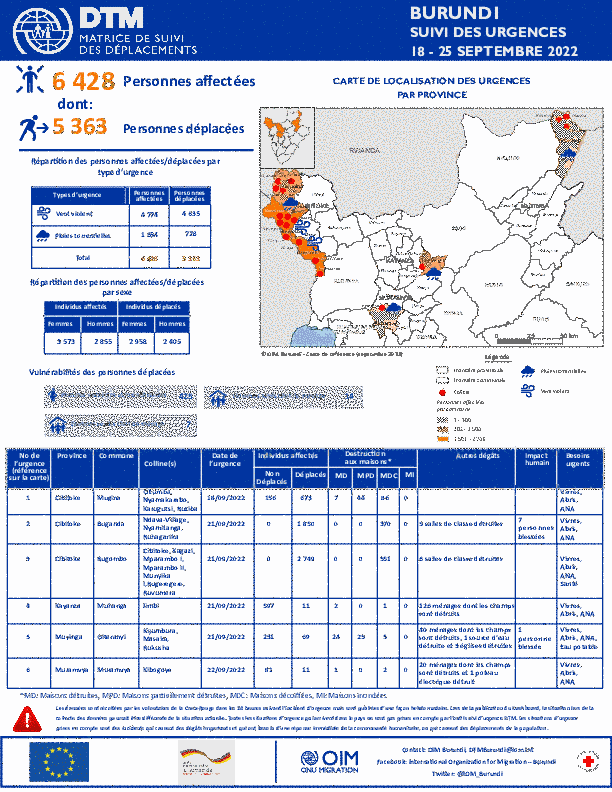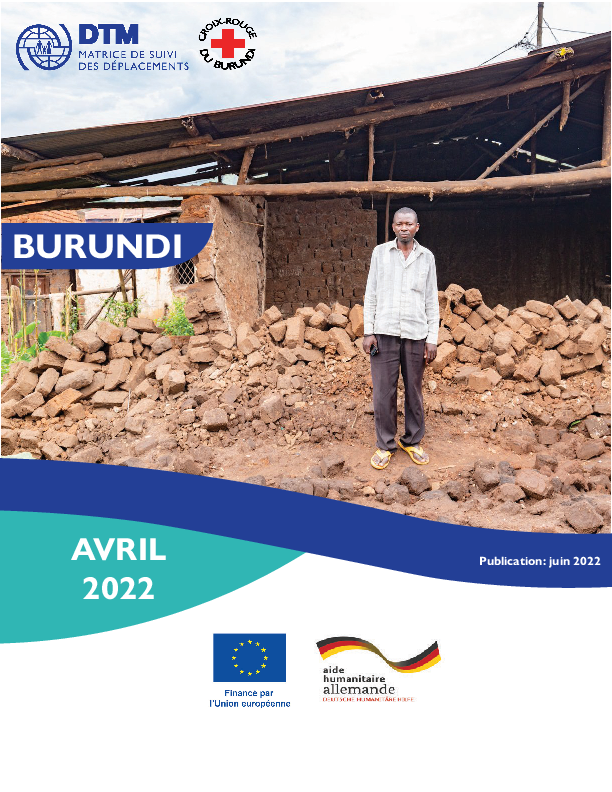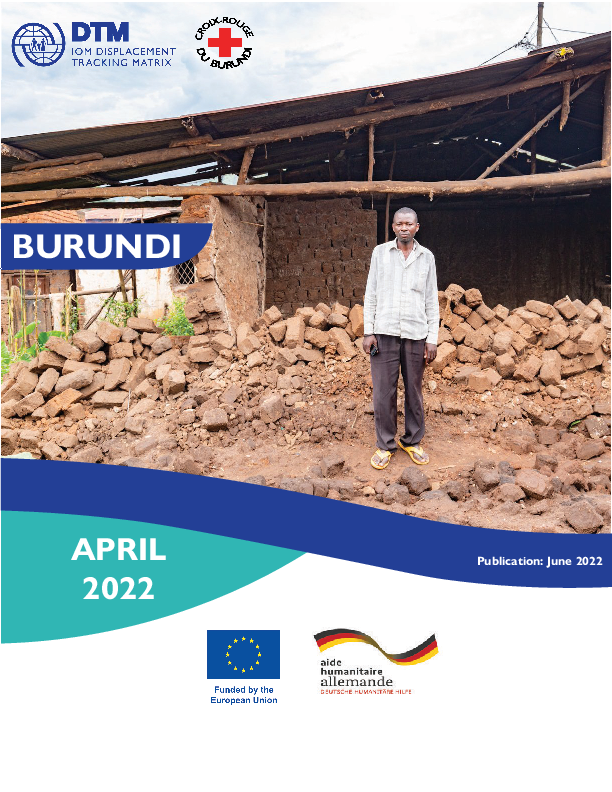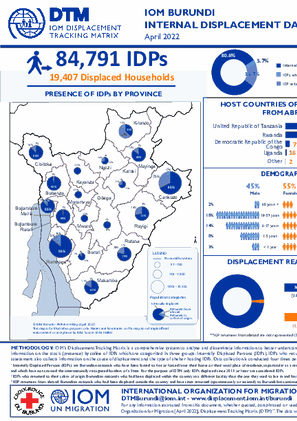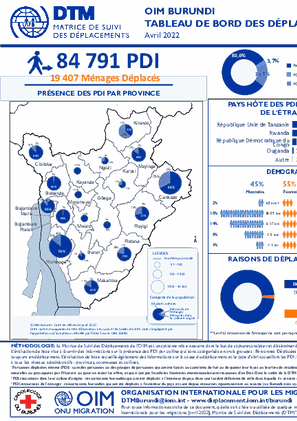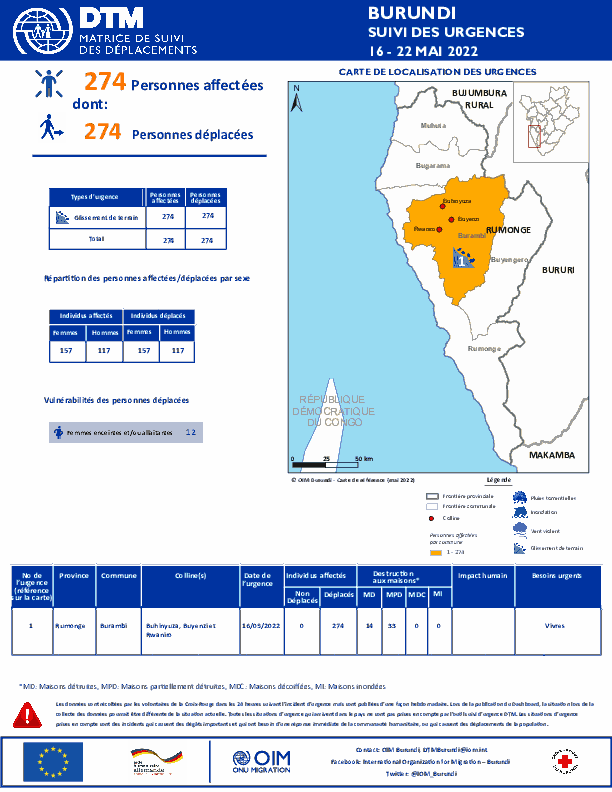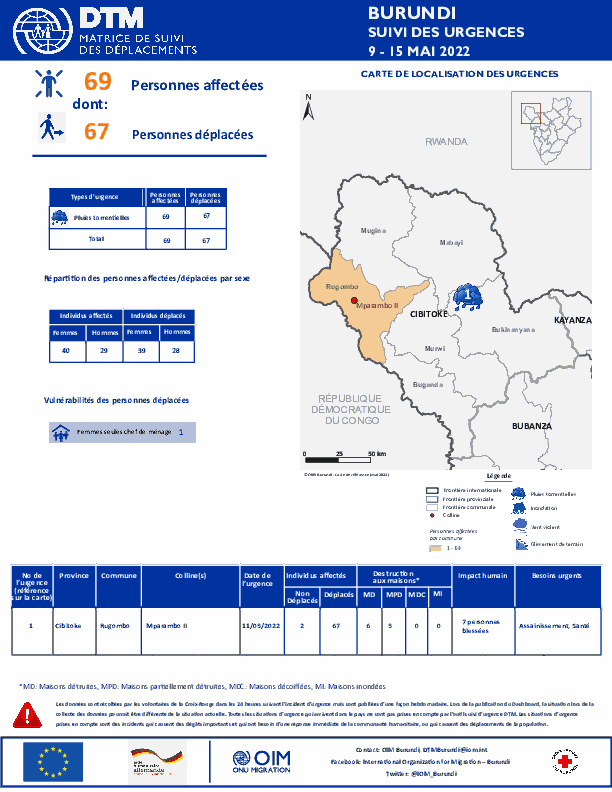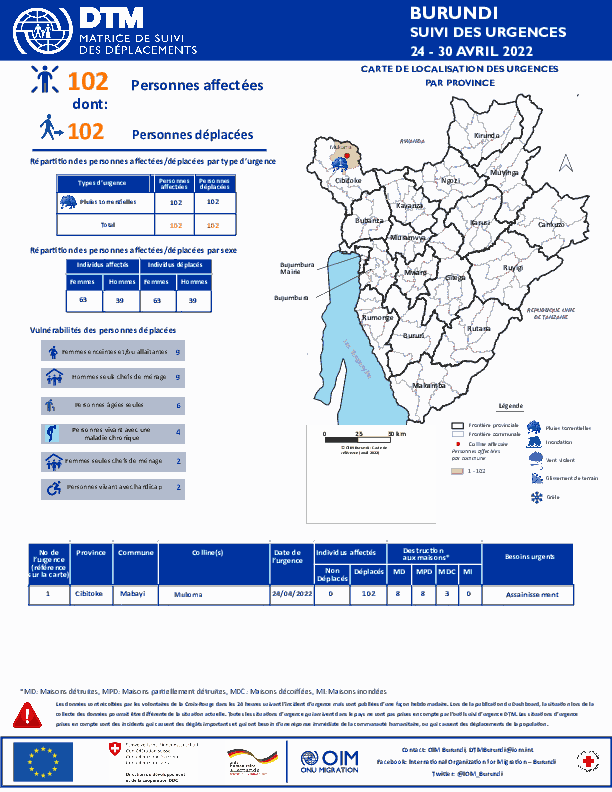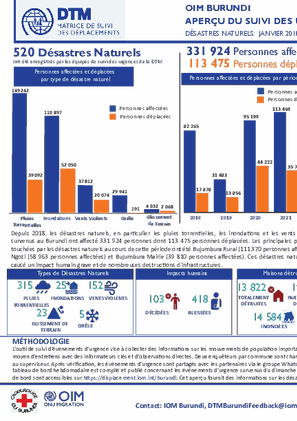-
Countries
-
Data and Analysis
-
Special Focus
-
Crisis Responses
Burundi
Burundi
IDPs tracked
Displacement Movements
8,100
IDMC 2023
Data collection round
About Burundi
In response to the great need for information on internally displaced persons (IDPs), their humanitarian profile and needs, as identified by the humanitarian community and the Burundian authorities, the International Organization for Migration (IOM) implemented DTM since 2015 to effectively and systematically track and assess internal population flows in Burundi and therefore provide reliable information on the current situation of IDPs.
The Displacement Tracking Matrix monitors IDPs on a national level and to identify their humanitarian needs. The DTM’s main objective is to maintain a comprehensive system of data collection and sharing on IDPs. The project relies on the synergy between IOM's DTM and the Burundi Red Cross (BRC), who are jointly responsible for data collection on internally displaced persons. The collected data includes figures on displacement, as well as displacement centres, provenance locations, approximate duration of displacement and humanitarian needs of the displaced populations. The information collected at various levels contributes to the construction of an overall profile of the displaced population in targeted provinces, which can then be used by the government and the humanitarian partners in order to protect, assist and advocate for IDPs.
In November 2018, DTM Burundi also began to collect data on movement at unofficial points of transit on the Burundi - Tanzania border. The information collected at the flow monitoring points enable the government, humanitarian partners and policy stakeholders, to understand migration trends on the national and regional levels.
Contact
DTMBurundi@iom.int
Current Donors
- PRM
- BHA
- Japan
- Republic of Korea
- Swiss (SDC)
- GFFO
Burundi — Suivi des urgences (11 - 17 décembre 2022)
Entre le 11 au 17 décembre 2022, la DTM a identifié 8 766 personnes affectées dont 531 personnes déplacées par les pluies torrentielles et les vents violents.
Burundi – Tableau de bord des déplacements internes (octobre 2022)
La DTM a identifié 75 300 personnes déplacées internes (PDI) réparties dans 17 128 ménages déplacés, 89% des déplacements étaient dus à des désastres nasturels et 11% à d'autre raisons.
Burundi – Internal Displacement Dashboard (October 2022)
DTM has identified 75,300 internally displaced persons (IDPs) in 17,128 households. Almost all displacements were due to natural disasters (89%), while 11% were due to other reasons.
Burundi — Suivi des urgences (28 novembre - 03 décembre 2022)
Entre le 28 novembre au 3 décembre 2022, la DTM a identifié 15 659 personnes affectées dont 315 personnes déplacées par les pluies torrentielles, des vents violents et la grêle.
Burundi — Suivi des urgences (21 - 27 Novembre 2022)
Entre le 21 au 27 novembre 2022, la DTM a identifié 212 personnes affectées dont 207 personnes déplacées réparties dans 62 ménages par les pluies torrentielles dans la province de Rutana.
Burundi — Suivi des Urgences (07 - 13 Novembre 2022)
Entre le 7 et le 13 novembre 2022, la DTM a identifié 88 personnes affectées, dont 70 personnes déplacées, par des pluies torrentielles et vents violents dans les provinces de Ruyigi, Bururi et Makamba.
Burundi — Suivi des urgences (31 Octobre — 6 Novembre 2022)
La DTM Burundi a le plaisir de vous partager (dans le lien ci-dessus) des informations sur les urgences qui se sont produites au Burundi en dates du 31 octobre au 6 novembre 2022.
Burundi — Suivi des urgences (24 — 30 Octobre 2022)
La DTM Burundi a le plaisir de vous partager (dans le lien ci-dessus) des informations sur les urgences qui se sont produites au Burundi en dates du 24 au 30 octobre 2022.
Burundi — Suivi des urgences (17 — 23 Octobre 2022)
La DTM Burundi a le plaisir de vous partager (dans le lien ci-dessus) des informations sur les urgences qui se sont produites au Burundi en dates du 17 au 23 octobre 2022.
Burundi — Suivi des urgences ( 3 au 9 Octobre 2022)
La DTM Burundi a le plaisir de vous partager (dans le lien ci-dessus) des informations sur les urgences qui se sont produites au Burundi en dates du 3 au 9 octobre 2022.
Burundi – Internal Displacement Dashboard (July 2022)
DTM has identified 83,588 internally displaced persons (IDPs) in 19,047 households, 91% of the displacement were due to natural disasters and 9% other reasons.
Burundi – Tableau de bord des déplacements internes (juillet 2022)
La DTM a identifié 83 588 personnes déplacées internes (PDI) réparties dans 19 047 ménages déplacés, 91% des déplacements étaient dus à des désastres nasturels et 9% à d'autre raisons.
Burundi — Suivi des urgences (18 - 25 septembre 2022)
La DTM a identifié 6 428 personnes (1 281 ménages) affectées dont 5 363 personnes (1 055 ménages) déplacées par les pluies torrentielles et vents violents dans les provinces de Cibitoke, Kayanza, Muramvya et Muyinga.
Burundi — Suivi des urgences (4 - 17 septembre 2022)
La DTM a identifié 2 006 personnes (406 ménages) affectées dont 137 personnes (28 ménages) déplacées par les pluies torrentielles et vents violents dans les provinces de Bubanza et Kayanza.
Burundi – Déplacement interne: Rapport des Evaluations Multisectorielles des Localités (Avril 2022)
La DTM a identifié 84 791 personnes déplacées internes (PDI) dans 19 407 ménages déplacés dans les 18 provinces du Burundi au cours du mois d'avril 2022.
Burundi – Internal Displacement: Multisectoral Location Assessment Report (April 2022)
DTM identified 84,791 Internally Displaced Persons (IDPs) in 19,407 displaced households in the 18 provinces of Burundi during the month of April 2022.
Burundi — Rapport des enquêtes des flux de populations (Janvier 2022 - Mars 2022)
Ce rapport présente une analyse des enquêtes de suivi des flux (Flow Monitoring Survey, FMS) réalisées entre janvier 2022 et mars 2022.
Burundi – Internal Displacement Dashboard (April 2022)
DTM has identified 84,791 internally displaced persons (IDPs) in 19,407 households, 91% of the displacement were due to natural disasters and 9% other reasons in the month of April 2022 covering all 18 provinces of Burundi.
Burundi – Tableau de bord des déplacements internes (Avril 2022)
La DTM a identifié 84 791 personnes déplacées internes (PDI) réparties dans 19 407 ménages déplacés, 91% des déplacements étaient dus à des désastres naturels et 9% à d'autres raisons.
Burundi — Suivi des urgences (16 - 22 Mai 2022)
Le DTM a identifié, le 16 mai 2022, 274 personnes déplacées dans la province de Rumonge en raison de glissements de terrains.
May 23 2022
Burundi — Suivi des urgences (16 - 22 Mai 2022)
Burundi — Suivi des urgences (9 - 15 Mai 2022)
La DTM a identifié 69 personnes affectées dont 67 personnes déplacées par les pluies torrentielles dans la province de Cibitoke.
May 16 2022
Burundi — Suivi des urgences (9 - 15 Mai 2022)
Burundi — Suivi des urgences (24 - 30 avril 2022)
La DTM a identifié 102 personnes affectées dont 24 personnes déplacées par les pluies torrentielles dans la province de Cibitoke.
Burundi — Aperçu des désastres naturels (Janvier 2018 - Mars 2022)
Depuis 2018, les désastres naturels, en particulier les pluies torrentielles, les inondations et les vents violents survenus au Burundi ont affecté 331 924 personnes dont 113 475 personnes déplacées.
Burundi — Natural Disasters Overview (January 2018 - March 2022)
Since 2018, natural disasters, in particular torrential rains, floods and strong winds that occurred in Burundi affected 331,924 persons, including 113,475 individuals that have been displaced.
Pagination
Burundi - Baseline Assessment - Round 40
2019-05-06
A baseline assessment is a sub-component of mobility tracking. It aims to collect data on IDP, migrant or returnee population presence in a defined administrative area of the country.
Burundi — Flow Monitoring — April 2019
2019-04-30
Flow monitoring aims to derive quantitative estimates of the flow of individuals through specific locations and to collect information about the profile, intentions and needs of the people moving and to quantify highly mobile populations by providing a picture of complex mobility dynamics.
Burundi — Flow Monitoring — March 2019
2019-03-31
From 01 to 31 March 2019, 40,836 movements were observed at 8 flow monitoring points in the provinces of Muyinga, Cankuzo, Ruyigi and Rutana. Burundian nationals were most represented among incoming migrants to Burundi (77%) and among outgoing migrants to Tanzania (86%) as it is generally Burundians…
Burundi - Baseline Assessment - Round 39
2019-03-22
A baseline assessment is a sub-component of mobility tracking. It aims to collect data on IDP, migrant or returnee population presence in a defined administrative area of the country.
Burundi — Flow Monitoring — February 2019
2019-02-28
From 1 to 28 February 2019, 36,091 movements were registered at 8 flow monitoring points, namely Mbundi and Rusumo (Muyinga province), Mukambati and Ntibitobangwa (Cankuzo province), Mungano and Kabuyenge (Ruyigi province), Kwa Elidadi and Kwa Ntunaguzi (Rutana province). Burundian nationals were…
Burundi - Baseline Assessment - Round 38
2019-02-28
A baseline assessment is a sub-component of mobility tracking. It aims to collect data on IDP, migrant or returnee population presence in a defined administrative area of the country.
Burundi - Baseline Assessment Round 37
2019-01-30
A baseline assessment is a sub-component of mobility tracking. It aims to collect data on IDP, migrant or returnee population presence in a defined administrative area of the country.
Burundi - Emergency Tracking (20 - 26 January 2019)
2019-01-26
Activated on an ad hoc basis, the DTM Emergency Tracking provides early field reports at the beginning of a complex crisis, allowing IOM to gather, consolidate and disseminate baseline information on displacement and return figures at the onset of a newly emerging crisis. The DTM Emergency Tracking…
Burundi - Emergency Tracking - 30 Décembre 2018 au 5 Janvier 2019
2019-01-05
Activated on an ad hoc basis, the DTM Emergency Tracking provides early field reports at the beginning of a complex crisis, allowing IOM to gather, consolidate and disseminate baseline information on displacement and return figures at the onset of a newly emerging crisis. The DTM Emergency Tracking…
Burundi - Baseline Assessment Round 36
2018-12-31
A baseline assessment is a sub-component of mobility tracking. It aims to collect data on IDP, migrant or returnee population presence in a defined administrative area of the country.
Burundi - Emergency Tracking (23 - 29 Décembre 2018)
2018-12-29
Activated on an ad hoc basis, the DTM Emergency Tracking provides early field reports at the beginning of a complex crisis, allowing IOM to gather, consolidate and disseminate baseline information on displacement and return figures at the onset of a newly emerging crisis. The DTM Emergency Tracking…
Burundi - Emergency Tracking (16 - 22 Décembre 2018)
2018-12-22
Activated on an ad hoc basis, the DTM Emergency Tracking provides early field reports at the beginning of a complex crisis, allowing IOM to gather, consolidate and disseminate baseline information on displacement and return figures at the onset of a newly emerging crisis. The DTM Emergency Tracking…
Burundi - Baseline Assessment Round 35
2018-11-30
A baseline assessment is a sub-component of mobility tracking. It aims to collect data on IDP, migrant or returnee population presence in a defined administrative area of the country.
Burundi - Flow Monitoring - October 2018
2018-10-31
Flow monitoring aims to derive quantitative estimates of the flow of individuals through specific locations and to collect information about the profile, intentions and needs of the people moving and to quantify highly mobile populations by providing a picture of complex mobility dynamics.
Burundi - Baseline Assessment Round 34
2018-10-31
A baseline assessment is a sub-component of mobility tracking. It aims to collect data on IDP, migrant or returnee population presence in a defined administrative area of the country.
Burundi - Baseline Assessment Round 33
2018-09-30
A baseline assessment is a sub-component of mobility tracking. It aims to collect data on IDP, migrant or returnee population presence in a defined administrative area of the country.
Burundi - Baseline Assessment Round 32
2018-08-31
A baseline assessment is a sub-component of mobility tracking. It aims to collect data on IDP, migrant or returnee population presence in a defined administrative area of the country.
Burundi - Baseline Assessment Round 31
2018-07-31
A baseline assessment is a sub-component of mobility tracking. It aims to collect data on IDP, migrant or returnee population presence in a defined administrative area of the country.
Burundi - Données de la fiche commune Juin 2018 - Round 30
2018-06-30
A baseline assessment is a sub-component of mobility tracking. It aims to collect data on IDP, migrant or returnee population presence in a defined administrative area of the country.
Burundi - Données de la fiche commune Mai 2018 - Round 29
2018-05-31
A baseline assessment is a sub-component of mobility tracking. It aims to collect data on IDP, migrant or returnee population presence in a defined administrative area of the country.


